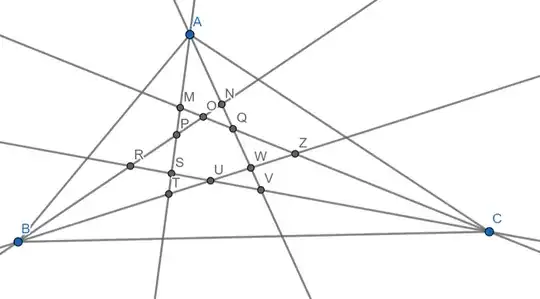Disclaimer : Not a direct answer but a methodology.
As your question can be understood as "how can I attack such an issue ?", I would like here to propose two combined tools for such questions involving angle bisectors in a triangle : trilinear coordinates $(u:v:w)$ (abbreviation here : t.c.) and their use with isogonal conjugation $(u:v:w) \leftrightarrow (\tfrac{1}{u}:\tfrac{1}{v}:\tfrac{1}{w})$.
I will show it through a configuration of 8 points (see figures 1 and 2) sharing some points with your own configuration.

Fig. 1 : A case where the angles aren't trisected in 3 equal values (not a "Morley configuration").

Fig. 2 : A Morley configuration for a general triangle.
This configuration is determined by a single point with t.c. $(u:v:w)$ in the following way (see the correspondence with Fig. 1 (and your own figure) :
$$\begin{cases}
(u:v:w)&\text{red disk}\\
(\tfrac{1}{u}:v:w)&\text{blue star ; your point O}\\
(u:\tfrac{1}{v}:w)&\text{green disk ; your point S}\\
(u:v:\tfrac{1}{w})&\text{yellow disk}\\
(u:\tfrac{1}{v}:\tfrac{1}{w})&\text{blue disk ; your point U}\\
(\tfrac{1}{u}:v:\tfrac{1}{w})&\text{green star ; your point Q}\\
(\tfrac{1}{u}:\tfrac{1}{v}:w)&\text{yellow star ; your point P}\\
(\tfrac{1}{u}:\tfrac{1}{v}:\tfrac{1}{w})&\text{red star}
\end{cases}$$
where two points with the same color are isogonal conjugates ; for example the yellow disk is conjugated with the yellow star (their t.c. are inverted componentwise).
Remarks :
This (2D!) points configuration can be considered as the perspective view of a cube represented with its 3 families of parallel edges prolongated until they meet resp. in $A,B,C$, playing the rôle of points at infinity.
The (extended) Morley configuration and its description in terms of t. c. can be found here.
Matlab program :
function main;
close all;
set(gcf,'color','w');axis off;hold on;
A=3*i+1;B=0;C=5;plot([A,B,C,A],'k');hold on;axis equal
a=abs(B-C);b=abs(C-A);c=abs(A-B);
cA=2*cos(aA/3);cB=2*cos(aB/3);cC=2*cos(aC/3);
% u=0.7;v=0.8;w=0.9
% For a Morley configuration :
u=sqrt(cA/(cB*cC));
v=sqrt(cB/(cC*cA));
w=sqrt(cC/(cA*cB));
z=T2C(u,v,w,'or');plot([z,A,z,B,z,C],'c');
z=T2C(1/u,v,w,'pb');plot([B,z,C],'c');
z=T2C(u,1/v,w,'og');plot([C,z,A],'c');
z=T2C(u,v,1/w,'oy');plot([A,z,B],'c');
z=T2C(u,1/v,1/w,'ob');plot([z,A],'c')
z=T2C(1/u,v,1/w,'pg');plot([z,B],'c')
z=T2C(1/u,1/v,w,'py');plot([z,C],'c')
z=T2C(1/u,1/v,1/w,'pr');
% Sanity check : classical Morley triangle
z=T2C(1,cA,cB,'*k');hold on
z=T2C(cC,1,cA,'*k');hold on
z=T2C(cB,cA,1,'*k')
function z=T2C(ta,tb,tc,g); % Trilinear to Cartesian coord.
global A B C a b c;
den=ata+btb+ctc;
k1=ata/den;k2=btb/den;
z=C+k1(A-C)+k2*(B-C);g2=g(2);
plot(z,g,'MarkerSize',10,'MarkerFaceColor',g2);hold on;



I suppose out of $2^3= 8$ combinations, only $4$ suffice to check due to symmetry.
– dezdichado Mar 31 '24 at 03:07